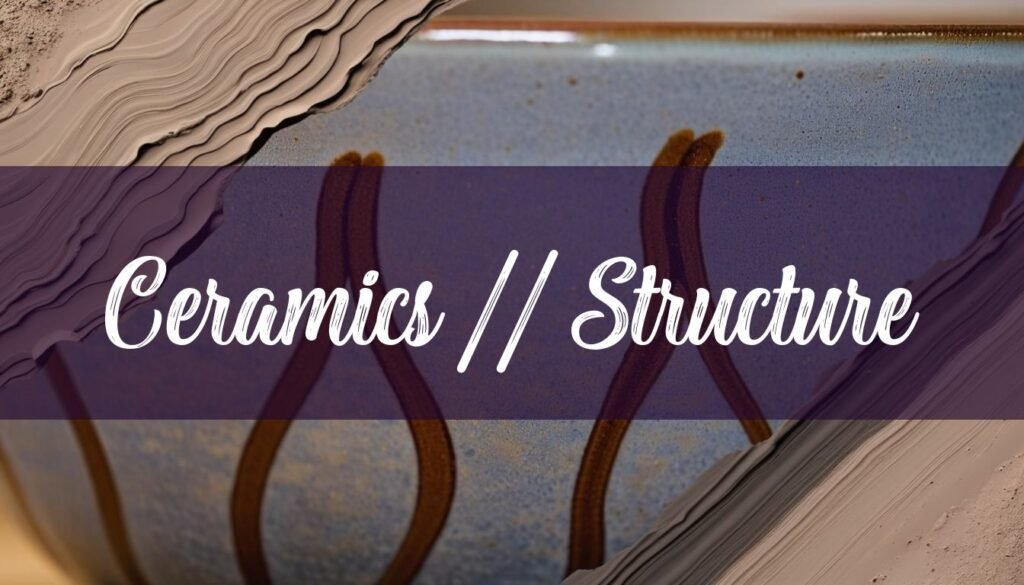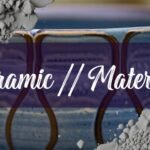Ceramics are a diverse group of materials that have been used for thousands of years, and continue to be essential in modern technology. By definition, ceramics are inorganic, non-metallic, polycrystalline materials, either natural or synthetic. These materials are composed of multiple crystal grains joined together during the production process, distinguishing them from monocrystalline materials, which are grown as single, three-dimensional crystals.
The properties and processing of ceramics are heavily influenced by their grain sizes, shapes, and the characteristics of their microstructure, including density, hardness, mechanical strength, and optical properties.
The versatility of ceramics allows their properties to be tailored for specific applications through modifications in composition, the creation of composite materials with metals and polymers, and adjustments to processing parameters.
Composition and Bonding
The chemical bonds within ceramics, primarily ionic and covalent, are fundamental to their unique characteristics. Ionic bonds, which occur between metals and nonmetals with significant electronegativity differences, involve the transfer of electrons, creating positively charged cations and negatively charged anions that attract each other through strong electrostatic forces.
Covalent bonds, conversely, form between two nonmetals with similar electronegativity, sharing electron pairs between the atoms.
While both types of bonds are present in ceramic materials, ionic bonding is predominant in most, especially oxides. These ionic and covalent bonds give rise to properties such as high hardness, high melting points, low thermal expansion, and good chemical resistance.
However, they also contribute to brittleness, a significant limitation that requires reinforcement strategies to prevent fractures.
The primary compositional classes of engineering ceramics include oxides, nitrides, and carbides. A notable example is alumina (Al2O3), a compound of aluminum and oxygen atoms. The crystal structures of ceramics are diverse, leading to a wide array of properties. While ceramics are generally known as electrical and thermal insulators, certain ceramic oxides form the basis for high-temperature superconductivity, demonstrating the versatility of these materials. You can even explore the world of
ceramic art as a study in beauty and critique, highlighting the diverse applications of these materials.
The microstructure of high-temperature engineering ceramics consists of the crystal phase, glass phase, and gas phase. The crystal phase, with its ordered atomic arrangement, significantly contributes to the ceramic’s mechanical properties.
In contrast, the glass phase is amorphous, lacking long-range order, while the gas phase often manifests as pores or voids resulting from the manufacturing process.
Ultra-High Temperature Ceramics
Ultra-high temperature ceramics (UHTCs) are a specialized class of ceramics designed to withstand extremely high temperatures, typically above 2000 °C. These materials are usually borides, carbides, nitrides, and oxides of early transition metals. Among these, zirconium diboride (ZrB2) and hafnium diboride (HfB2) in composites containing about 20% silicon carbide (SiC) have demonstrated the best performance. For a deeper dive, consider exploring what
what ceramics are used for.
Research over the past two decades has largely focused on enhancing the performance of ZrB2 and HfB2, while also characterizing the nitrides, oxides, and carbides of group four and five elements. UHTCs exhibit strong covalent bonding, which provides structural stability at high temperatures. Carbides like HfC, ZrC, TiC, and TaC have high melting points due to their covalent carbon networks, though carbon vacancies are common.
Nitrides such as ZrN and HfN also possess strong covalent bonds but are difficult to synthesize and process due to their refractory nature. Ceramic borides like HfB2 and ZrB2 benefit from strong boron-boron and metal-boron bonds; their hexagonal close-packed structure, with alternating two-dimensional boron and metal sheets, provides high but anisotropic strength in single crystals.
The thermal and mechanical properties of UHTCs are critical for their high-temperature applications. Diboride-based UHTCs generally exhibit higher thermal conductivity compared to carbide and nitride-based ceramics. Research aims to improve their toughness and oxidation resistance through composites with silicon carbide, fiber incorporation, and the addition of rare-earth hexaborides like lanthanum hexaboride (LaB6). The inclusion of silicon carbide enhances the oxidation resistance of HfB2 and ZrB2 by forming a protective glassy surface layer of SiO2 at temperatures above 1,000 °C.
The addition of SiC to ZrB2 lowers its operating temperature from 3,245 °C to 2,270 °C. These materials are essential in extreme conditions, with applications in clean energy and space exploration. Recent advances in hypersonic travel and nuclear technology have highlighted the importance of UHTCs due to their high melting points, high thermal conductivity, and strong metal-to-non-metal bonding.
Manufacturing and Failure Mechanisms
The manufacturing of high-temperature ceramics begins with selecting and preparing raw materials, followed by shaping processes like pressing, extrusion, injection molding, casting, or 3D printing. Green machining, the mechanical processing of the ceramic blank in its unfired state, allows for cost-effective processing due to the material’s low strength at this stage.
After green machining, the ceramic blanks undergo debinding, which may occur as a separate step or as part of the sintering process, depending on the material. Sintering involves compressing and solidifying the material at high temperatures below the melting point, creating a ceramic bond and achieving the desired final properties.
Different processes and furnaces are used based on the material, varying in temperature, firing time, and atmosphere. Final machining includes precise mechanical processing steps like grinding, polishing, and drilling to achieve tight tolerances and smooth surfaces.
The failure of ceramics at high temperatures typically occurs through the nucleation, growth, and coalescence of cracks. This process involves diffusive cavity nucleation and growth within a damage zone or at microstructural heterogeneities. Continuous crack nucleation at microstructural heterogeneities and the crack coalescence process lead to eventual failure.
To mitigate these failure mechanisms, ceramic composite materials are used to improve toughness. These composites exhibit excellent corrosion and oxidation resistance, as well as good friction and wear characteristics. Phenomena such as interfacial debonding and sliding, crack deflection, and crack bridging between the fiber and matrix material enhance the material’s overall performance.
Applications and Ongoing Research
High-temperature ceramics are utilized in various industries due to their exceptional mechanical, thermal, and electrical properties. These include aerospace, automotive, chemical processing, and power generation. Their resistance to heat, wear, corrosion, and thermal shock makes them suitable for harsh operating conditions.
They are employed in temperature measurement, molten metal handling, heat treatment, ceramic manufacturing, power generation, and glass production. Specific applications include spark plugs, pressure sensors, X-ray tubes, bearings, ceramic plates, and welding components.
Current research focuses on enhancing the properties of high-temperature ceramics, such as increasing fracture toughness and reducing thermal expansion. This includes exploring novel materials, composites, and surface treatments. Recent developments involve high-entropy UHTCs, which show promise as emerging ultra-high temperature materials. For those interested in creating such materials, it’s useful to know
how to make stoneware, a durable and versatile ceramic.
Improved processing and oxidation resistance of ZrB2 ultra-high temperature ceramics containing SiC nanodispersoids are also being explored. Researchers are also investigating nanoceramic composites with duplex microstructures to overcome the strength-toughness tradeoff, and HfB2-CNTs composites with enhanced mechanical properties prepared by spark plasma sintering.
These efforts aim to create materials that can withstand the most extreme conditions, enabling advancements in various high-tech sectors.





